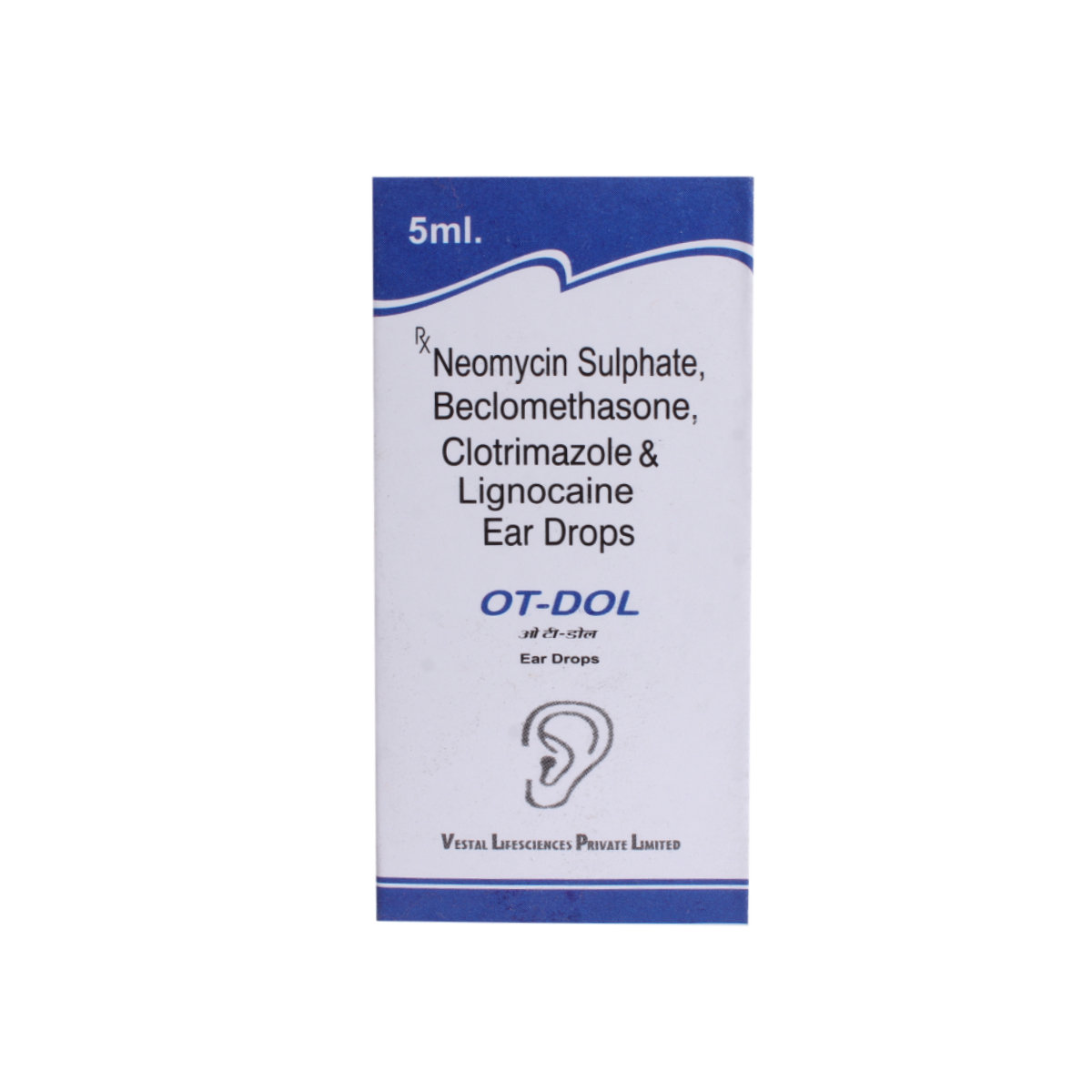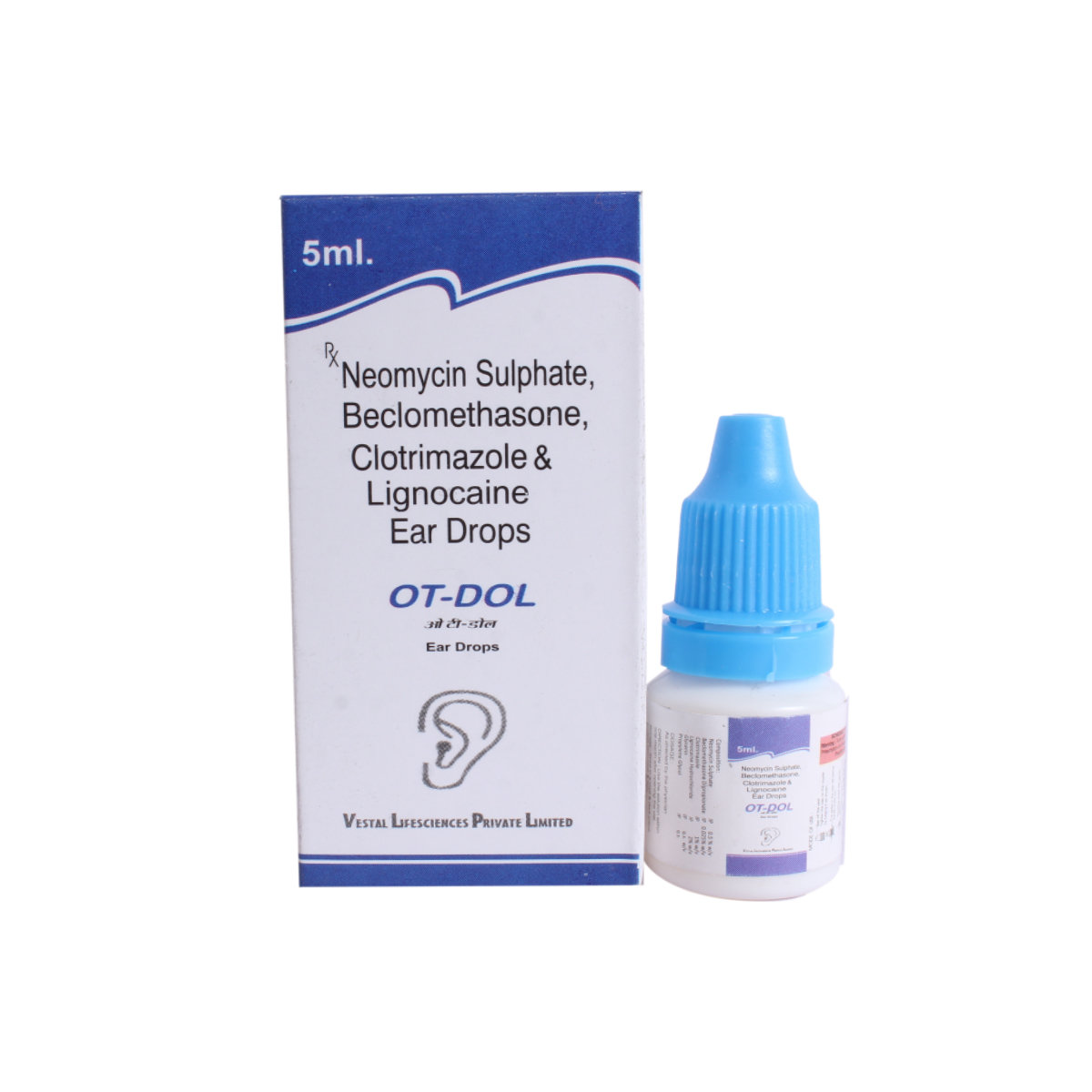Ot-Dol Ear Drops 5ml



MRP ₹89
(Inclusive of all Taxes)
₹13.3 Cashback (15%)
know your delivery time
Provide Delivery Location

Secure Payment

Trusted by 8 Crore Indians

Genuine Products
Therapeutic Class
Country of origin
Manufacturer/Marketer address
Author Details
We provide you with authentic, trustworthy and relevant information
Disclaimer
Alcohol
Safe if prescribed
No interaction found/ established. Please consult your doctor before using Ot-Dol Ear Drops 5ml.
Pregnancy
Consult your doctor
Please consult your doctor if you are planning to become pregnant or already pregnant before starting Ot-Dol Ear Drops 5ml.
Breast Feeding
Consult your doctor
There is limited data on how Ot-Dol Ear Drops 5ml affects breastfeeding. Please consult your doctor before starting Ot-Dol Ear Drops 5ml.
Driving
Safe if prescribed
Ot-Dol Ear Drops 5ml has no or negligible influence on the ability to drive or use machines.
Liver
Consult your doctor
Let your doctor know if you have any history of liver diseases or hepatic impairment. Your doctor will weigh the benefits and potential risks before prescribing Ot-Dol Ear Drops 5ml.
Kidney
Consult your doctor
Let your doctor know if you have any history of kidney diseases. Your doctor will weigh the benefits and potential risks before prescribing Ot-Dol Ear Drops 5ml.
Children
Safe if prescribed
The doctor will decide the dosage and duration of Ot-Dol Ear Drops 5ml based on the child's age and body weight.
Product Substitutes
About Ot-Dol Ear Drops 5ml
Ot-Dol Ear Drops 5ml is a combination medicine primarily used to treat an ear infection. An ear infection occurs when microbes like bacteria and virus infect the middle ear (air-filled space behind the eardrum). Symptoms include ear pain, fever, irritability, drainage of fluid from the ear and hearing loss.
Ot-Dol Ear Drops 5ml is composed of four medicines: Beclometasone (corticosteroid), Clotrimazole (antifungal), Lidocaine (local anaesthetic), and Ofloxacin (antibiotic). Beclometasone is a corticosteroid that blocks the production of prostaglandins (chemical messengers) that make the affected area red, swollen and itchy. Clotrimazole is an antifungal medication. It stops the growth of fungi by causing damage and leakage to the fungal cell membrane. Lidocaine causes temporary numbness/loss of feeling in the skin and mucous membranes. Ofloxacin is bactericidal (kills bacteria) and works by inhibiting bacterial DNA gyrase, an enzyme required for the replication, transcription and repair of the DNA.
Your doctor will decide the dosage of Ot-Dol Ear Drops 5ml based on the severity of your infection. If the medicine gets into your eyes, nose or mouth, rinse with cold water. Ot-Dol Ear Drops 5ml has common side effects as every drug does. These side effects include ear discomfort and irritation at the application site.
Let your doctor know if you have any allergic reactions to Ot-Dol Ear Drops 5ml or any other medications. Please check with your doctor before using Ot-Dol Ear Drops 5ml if you have adrenal gland problems, cataract or glaucoma, liver or kidney diseases, and heart problems. Pregnant and breastfeeding mothers should consult the doctor before starting Ot-Dol Ear Drops 5ml. Drive or operate machinery only when you do not experience any discomfort in the ears while using ear drops.
Uses of Ot-Dol Ear Drops 5ml
Medicinal Benefits Mweb
Key Benefits
Ot-Dol Ear Drops 5ml is used to treat ear infections. It consists of Beclometasone, Clotrimazole, Lidocaine and Ofloxacin. Beclometasone belongs to the class of corticosteroids. It blocks the production of prostaglandins (chemical messengers) that make the affected area red, swollen and itchy. Clotrimazole is an antifungal medication that stops fungi' growth by causing damage and leakage to the fungal cell membrane. Lidocaine is a local anaesthetic and reduces pain by blocking the pain signals from nerves to the brain. It causes temporary numbness/loss of feeling in the skin and mucous membranes. Ofloxacin is a quinolone antibiotic that inhibits bacterial DNA gyrase, an enzyme required for the replication, transcription and repair of the DNA.
Directions for Use
Side Effects of Ot-Dol Ear Drops 5ml
- Ear discomfort
- Irritation at the application site
Drug Warnings
Before using Ot-Dol Ear Drops 5ml, let your doctor know if have a history of liver or kidney diseases, adrenal gland problems, cataract, glaucoma, diabetes or allergic reactions to Ot-Dol Ear Drops 5ml. Let your doctor know if you plan to become pregnant or already pregnant and a lactating mother. Do not take Ot-Dol Ear Drops 5ml on your own since it may lead to antibiotic resistance, failing the antibiotics to act against specific bacterial infections.
Drug-Drug Interactions Checker List
- ACETAMINOPHEN
- ASPIRIN
- IBUPROFEN
- NAPROXEN
- CELECOXIB
- DICLOFENAC
- INDOMETHACIN
- MELOXICAM
- PREDNISONE
- INSULIN
- THEOPHYLLINE
- WARFARIN
Habit Forming
Diet & Lifestyle Advise
- Include more fibre-enriched food in your diet, as it can be easily digested by your gut bacteria, which helps stimulate their growth. Thus, fibre foods may help restore healthy gut bacteria after a course of antibiotics. Whole grains like whole-grain bread, and brown rice should be included in your diet.
- Eating grapefruit during antibiotics treatment can prevent the body from utilizing Ot-Dol Ear Drops 5ml properly. So, avoid intake of grapefruit or grapefruit juice with the antibiotic.
- Avoid taking too much calcium, iron-enriched foods and drinks as it might affect the working of Ot-Dol Ear Drops 5ml.
- Avoid intake of alcoholic beverages with Ot-Dol Ear Drops 5ml as it can make you dehydrated and affect your sleep. This can make it more challenging for your body to aid the Ot-Dol Ear Drops 5ml in fighting off infections.
- Manage stress, eat healthily, drink plenty of water, exercise regularly, and get plenty of sleep.
All Substitutes & Brand Comparisons
RX
Out of StockKostic AC Ear Drop
Elkos Healthcare Pvt Ltd
₹54
(₹4.86/ 1ml)
69% CHEAPERRX
Out of StockWaxowell Ear Drop
Vrinda Life
₹52
(₹9.36/ 1ml)
41% CHEAPER

Have a query?
Buy best Ear, Nose & Oropharynx products by
Entod Pharmaceuticals Ltd
Cipla Ltd
NuLife Pharmaceuticals
Nri Vision Care India Ltd
Lincoln Pharmaceuticals Ltd
Glenmark Pharmaceuticals Ltd
Macleods Pharmaceuticals Ltd
Pristine Pearl Pharma Pvt Ltd
Centaur Pharmaceuticals Pvt Ltd
Dr Reddy's Laboratories Ltd
Lupin Ltd
Zydus Healthcare Ltd
Indoco Remedies Ltd
Intas Pharmaceuticals Ltd
Mankind Pharma Pvt Ltd
GlaxoSmithKline Pharmaceuticals Ltd
Leeford Healthcare Ltd
Megma Healthcare Pvt Ltd
Sapient Laboratories Pvt Ltd
Sun Pharmaceutical Industries Ltd
Zuventus Healthcare Ltd
Zydus Cadila
Auskincare Formualation Pvt Ltd
Alkem Laboratories Ltd
Bell Pharma Pvt Ltd
Chethana Pharmaceuticals
Dwd Pharmaceuticals Ltd
German Remedies Ltd
Kaizen Drugs Pvt Ltd
Torque Pharmaceuticals Pvt Ltd
Vilco Laboratories Pvt Ltd
Avilius Neutracare
Biochem Pharmaceutical Industries Ltd
Blubell Pharma
Delcure Life Sciences Ltd
Eris Life Sciences Ltd
Kavach 9 Pharma & Research Pvt Ltd
Medishri Healthcare Pvt Ltd
NVK Pharma
Optho Remedies Pvt Ltd
Ordain Health Care Global Pvt Ltd
Respionix Healthcare Pvt Ltd
Troikaa Pharmaceuticals Ltd
Xseed Pharma
Abbott India Ltd
Atopic laboratories Pvt Ltd
Cadila Pharmaceuticals Ltd
Clyde Pharmaceutical Pvt Ltd
East India Pharmaceutical Works Ltd
FDC Ltd
Incus Pharmaceuticals Pvt Ltd
Meridian Enterprises Pvt Ltd
Micro Labs Ltd
Morepen Laboratories Ltd
Nextgen Healthcare
Novalab Healthcare Pvt Ltd
Ocuris Pharmaceuticals Pvt Ltd
Precept Pharma
Salvador Visiontech Pvt Ltd
Sunways (India) Pvt Ltd
Timon Pharmaceuticals Pvt Ltd
Unison Pharmaceuticals Pvt Ltd
Aar Ess Remedies Pvt Ltd
Adley Formulations
Ajanta Pharma Ltd
Alercon Pharma Pvt Ltd
Apex Laboratories Pvt Ltd
Aver Pharmaceuticals Pvt Ltd
BMW Pharmaco India Pvt Ltd
Bio Warriors Pharmaceucticals Pvt Ltd
Casca Remedies Pvt Ltd
Elan Pharma India Pvt Ltd
Elivia Life Sciences Pvt Ltd
Elkos Healthcare Pvt Ltd
Floreat Medica Pvt Ltd
Healthgate Pvt Ltd
Ikon Remedies Pvt Ltd
Ipca Laboratories Ltd
Koye Pharmaceuticals Pvt Ltd
Lividus Pharmaceuticals Pvt Ltd
Orn Remedies Pvt Ltd
Rosa Lifesciences
Siloam Pharmaceuticals Pvt Ltd
Sitnez Biocare Pvt Ltd
Srigan Anatto Care Pvt Ltd
Uniza Healthcare Llp
Vatican Life Sciences Pvt Ltd
Welgenic Pharma
Wellok Pharma
West Coast Pharmaceuticals Pvt Ltd
Win Medicare Ltd
Zee Laboratories Ltd
Abyss Pharma Pvt Ltd
Accent Pharmaceuticals & Diagnostics
Alembic Pharmaceuticals Ltd
Alencure Biotech Pvt Ltd
Austere
Bacans Biotech Pvt Ltd
Biopolis Life Sciences Pvt Ltd
Biosys Medisciences



